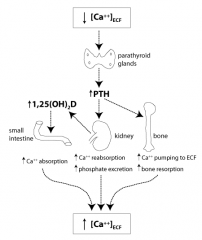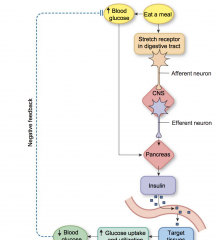![]()
![]()
![]()
Use LEFT and RIGHT arrow keys to navigate between flashcards;
Use UP and DOWN arrow keys to flip the card;
H to show hint;
A reads text to speech;
56 Cards in this Set
- Front
- Back
|
Hormones |
Chemical messengers secreted into blood by endocrine glands to transport to a distant target. Responsible for many long term functions. ie. Metabolism and regulation of internal environment Act at very small concentrations |
|
|
What are 3 basic ways hormones act on a cell? |
1) Control rates of enzymatic reactions 2) Control transport of ions or molecules across the cell membrane 3) Controlling gene expression and synthesis of proteins |
|
|
How to identify an endocrine gland: |
1) Remove gland to induce effects of hormone deficiency 2) Replace hormone and see if normal behavior resumes 3) Create a state of hormone excess to see if symptoms appear -Identified like this, then they are known as classic hormones |
|
|
What can secrete hormones? |
glands, isolated endocrine cells, neurons and sometimes the immune system. |
|
|
Secretion |
movement of a substance from inside a cell to ECF or external environment |
|
|
ectohormone |
hormone secreted to external environment |
|
|
pheromones |
specialized ectohormones that act on another organism of the same species to elicit a physiological or behavioral response. |
|
|
Candidate hormones |
These may be hormones , but we are not sure yet. Usually identified by having 'factor' in their name. ie. growth factor. Some play roles in both short and long distance effects (CCK) |
|
|
Cellular mechanism of action |
The response after hormones bind to target cell receptors |
|
|
Hormone half-life |
Rate of breakdown in the bloodstream |
|
|
How can hormones be degraded or stop their action? |
-degraded by metabolites in bloodstream -Enzymes in plasma can degrade peptide hormones bound to membrane receptors -endocytosis and then digested by a lysosome -intracellular enzymes digest hormones that enter |
|
|
What are the 3 classifications of hormones? |
- Peptide hormones - Steroid hormones - Amine hormones |
|
|
Peptide hormones |
Main type of hormone in body. Lipophobic and hydrophillic Bind to surface membrane receptors: response through signal transduction (cAMP 2nd messenger system and some through tyrosine kinase activity) Usually a rapid response. Can open/close channels, modulate metabolic enzymes, or transport proteins. |
|
|
Steroid hormones |
lipophillic and hydrophobic Cholesterol derived. Can easily diffuse across the membrane Only made from adrenal cortex, gonads, and skin (vitamin D). Cells that secrete these have large ER. Most are found in blood bound protein carriers (corticosteroid-binding globulin or albumin) which protect from enzymatic breakdown and also blocks the entry into cells (must follow the law of mass-balance). (about 98% is bound, 2% is free) Receptors are typically in the cytoplasm or on the nucleus (act as transcription factors). Mainly genomic effects, and some have nongenomic effects and bind to receptor on the membrane for a more rapid effect. |
|
|
Amine Hormones |
Small molecules either made from tryptophan or tyrosine. 2 types: -Catecholamines: Neurohormones, bind to receptors like peptide receptors. lipophobic and hydrophillic. Dissolves in blood -Thyroid Hormones: Behave more like steroid hormones with intracellular receptors to activate gene regulation and synthesis. lipophillic and hydrophobic. Bound to carrier proteins in blood. |
|
|
Catecholamines |
Amine hormone. Neurohormones, bind to receptors like peptide receptors. lipophobic and hydrophillic. Dissolves in blood |
|
|
Thyroid Hormones |
Amine hormone Behave more like steroid hormones with intracellular receptors to activate gene regulation and synthesis. lipophillic and hydrophobic. Bound to carrier proteins in blood. |
|
|
What are the control pathways for hormones? |

Reflex pathways. In simple endocrine pathways, the cell acts as both the sensor and the integrating center, and therefore relies on negative feedback. ie Parathyroid hormone and calcium homeostasis
|
|
|
Blood glucose reflex pathway |

|
|
|
Neurohormones |
Chemical signals released into blood by neurons. 3 types: -catecholamines: from adrenal medulla -Hypothalamic neurohormones from posterior pituitary -hypothalamic neurohormones from anterior pituitary |
|
|
Anterior Pituitary |
-True endocrine gland of epithelial origin. Also known as adenohypophysis and its secretions are known as adenohypophyseal secretions. -Secretes 6 hormones: Prolactin, Thyroid Stimulating Hormone, Adrenocorticotropin, Growth hormone, follicle stimulating hormone, and leuteinizing hormone. -Secretions are controlled by releasing or inhibiting hypothalamic neurohormones. -Has a portal system to avoid dilution of neurohormones. 2 sets of capillaries connected in series with portal veins. Hypothalamic-hypophyseal portal system |
|
|
Posterior pituitary |
Extension of neural tissue of the brain. Secretes neurohormones made by the hypothalamus. - Antidiuretic hormone (vassopressin) -oxytocin |
|
|
Vassopressin (Antidiuretic hormone) |
Acts on kidneys to regulate water balance ing body. |
|
|
Oxytocin |
Controls ejection of milk for breast feeding and contractions of uterus during labor and delivery. Important role in social, sexual, and maternal behavior. |
|
|
Prolactin |
PRL. Controls lactation in female breast, immune function. One of two anterior pituitary hormones with hypothalamic release-inhibiting hormones |
|
|
Growth hormone |
GH or Somatotropin. Anterior pituitary hormone. Affects metabolism of many tissues and stimulates hormone production. Has hypothalamic release-inhibiting hormone (somatostatin or growth hormone inhibiting hormone, GHIH) |
|
|
Follicle Stimulating Hormone |
FSH. A gonadotropin. Effects the ovaries and the testes. Growth of ovarian follicles and the production of sperm. |
|
|
Leuteinizing Hormone |
LH. A gonadotropin. Effect the ovaries and testes. Ovulation and secretion of testosterone. |
|
|
Thyroid Stimulating Hormone |
TSH. Thyrotropin. Controls hormone synthesis and secretion in the thyroid gland. Hormones that are released from thyroid are T3 and T4. |
|
|
Adrenocorticotrophic hormone |
ACTH. Adrenocorticotropin. Acts on certain cells of adrenal cortex to control synthesis and release of corticosteroids (cortisol). |
|
|
What is different about the feedback loops in the hypothalamic-pituitary pathway? |
When the anterior pituitary hormones act as trophic hormones , there are 3 integrating centers: the hypothalamus, anterior pituitary, and the endocrine target. Instead of negative feedback, the hormones themselves are the feedback signal. |
|
|
long-loop negative feedback |
This is the dominant type of feedback in the hypothalamic-pituitary pathways. Hormones secreted by the peripheral endocrine gland feeds back to suppress secretion of its anterior pituitary and hypothalamic hormones. The exception are the ovarian hormones. |
|
|
short-loop negative feedback |
A pituitary hormone feeds back to decrease the hormone secretion by the hypothalamus. ie. PRL, GH, ACTH This is usually secondary to long-loop feedback |
|
|
Ultra-short-loop feedback |
In the pituitary or the hypothalamus, the hormone acts as an autocrine or paracrine signal |
|
|
Cortisol pathway |
1) Integrating center: Hypothalamus 2) Hormone: Corticotropin releasing hormone is released from the hypothalamus 3) Integrating Center: Anterior Pituitary 4) Hormone: Adrenocoricotrophic hormone released from the anterior pituitary 5) Integrating center: Adrenal Cortex 6) Hormone: Cortisol is released from the adrenal cortex because of ACTH stimulus. Is long-loop feedback on the anterior pituitary and the hypothalamus. 7) Target tissue and response |
|
|
Synergism |
When the combined effect of two hormones is greater than the sum of the two effects individually. |
|
|
Permissiveness |
One hormone cannot fully exert its effects unless a second hormone is involved. |
|
|
Antagonism |
When two hormones oppose each other. (glucagon and insulin) |
|
|
Is there such a thing as a bad hormone? |
No. There needs to be a dynamic balance for a healthy life. Unbalance leads to disease. |
|
|
What does cortisol do? |
- increases gluconeogenesis - decreases the use of glucose - increases lipolysis - increases protein breakdown - decreases inflammation - decreases immune response |
|
|
What is released from acute stress? |
epinephrine from the adrenal medulla |
|
|
What are the 3 stages of a stress response? |
1) Alarm phase: epinephrine is released 2) Resistance phase: prolonged stress results in the release of cortisol from the adrenal cortex. This is for fuel mobilization, glucose conservation, and increase or maintain blood glucose concentrations. 3) Exhaustion phase: Breakdown of homeostasis, and the body can no longer deal with stress. |
|
|
Pancreas |
This is an exocrine and an endocrine gland. -endocrine cells are islets of langerhans. -Alpha cells secrete glucagon, increase blood glucose concentrations, and increase the breakdown of stored carbs primarily from the liver. -Beta cells secrete insulin. Decrease blood glucose concentrations, and increase the storage of carbs. |
|
|
Hypothalamus hormones |
Cause the release or inhibition of hormones from the anterior pituitary |
|
|
Thyrotropin releasing hormone |
TRH. From the hypothalamus. Releases TSH. |
|
|
Corticotropin releasing hormone |
CRH From the hypothalamus. Releases ACTH |
|
|
Gonadotropin releasing hormone |
GnRH From the hypothalamus. Releases LH and/or FSH |
|
|
Prolactin inhibiting hormone |
PIH From the hypothalamus. Inhibits PRL |
|
|
Prolactin releasing hormone |
From the hypothalamus. Releases PRL |
|
|
Growth hormone releasing hormone |
GHRH From the hypothalamus. GH is released |
|
|
Growth hormone inhibiting hormone |
Somatostatin From the hypothalamus. Inhibits GH |
|
|
Thyroid gland |
Secretes T4 (Thyroxine, inactive form) and T3 (Triiodothyronine, active form) Used for energy transformation and utilization and for the basal metabolic rate Release: 1) Hypothalamus releases TRH 2) Anterior pituitary releases TSH as a response to TRH 3) Thyroid gland releases T3 and T4 4) T3 and T4 feedback to the hypothalamus and anterior pituitary to turn off secretion of TRH and TSH |
|
|
Where are Corticosteroids made? |
Made in the adrenal cortex, a true endocrine gland. |
|
|
Where are catecholamines made? |
In the adrenal medulla, a modified sympathetic ganglion. |
|
|
What are the 3 classes of secretions from the adrenal cortex? |
1) Mineralocorticoids: Primary in aldosterone. Regulates Na, K, and water in the kidney. 2) Sex Steroids: Primary ones are dehydroepiandrosterone (DHEA) (most abundant steroid hormone in body) and androstendione. These are weakly androgenic and are precursor hormones for testosterone and estrogen. 3) Glucocorticoids: Primary one is cortisol. These increase the blood glucose concentration and suppress inflammation. |
|
|
Why is blood glucose so important? |
It is the best fuel for your brain, as the brain does not store any fuels in it. Critical for survival. |

